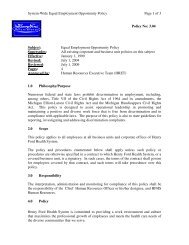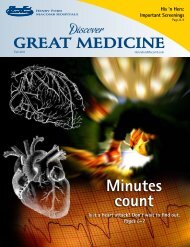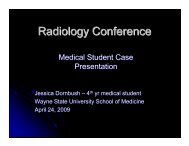Radiology Presentation - Henry Ford Health System
Radiology Presentation - Henry Ford Health System
Radiology Presentation - Henry Ford Health System
Create successful ePaper yourself
Turn your PDF publications into a flip-book with our unique Google optimized e-Paper software.
Department of <strong>Radiology</strong><strong>Henry</strong> <strong>Ford</strong> <strong>Health</strong> <strong>System</strong>Detroit, Michigan<strong>Henry</strong> <strong>Ford</strong> Hospital - <strong>Radiology</strong><strong>Presentation</strong>Darryl Ramsewak MS3Wayne State University School of MedicineDec 19, 2008
History of Present Illness• 56 year old male presenting with lowerback pain and right lower extremityweakness and pain.• No history of trauma to spine
Pertinent Past Medical History• History of testicular cancer 20 - 30 yearspreviously treated with orchiectomy andradiation therapy.
Coned Down Lateral Lumbar Spine Plain Film
Plain Film Findings• Subtle radiolucency seen at the posteriorportion of L3 vertebral body withoutcortical breakthrough.
MRI – T2 Sagittal
MRI – T1 Sagittal
MRI – T2 Axial
MRI – T1 Axial
MRI – Post Contrast T1 Axial
MRI – T1 Coronal View
MRI Findings• The visualized lesion invades the epidural space andconsequently compresses the thecal sac andpotentially some spinal cord roots, seen best on thesagittal images.• T2 images show a soft tissue lesion with hyperintenseperiphery and a central hypointensity at the posteriorportion of L3 vertebral body. The borders are irregular• T1 weighted images show a homogenous hypointenselesion compared to adjacent vertebral body marrow.
Bone Scan
Bone Scan Findings• Increased uptake at L3 vertebrae.
CT Scan
CT Scan Findings• Hypodense soft tissue lesion withassociated vertebral body lucency at theposterior aspect of the L3 vertebral body.
Differential Diagnosis• Metastatic Cancer• Lymphoma• Chordoma• Chondrosarcoma• Multiple Myeloma• Ecchordosis physaliphora
CT Guided Biopsy
Pathology Findings• “The specimen shows neoplasticepithelioid cells with clear cytoplasm andnuclear atypia. . Some cells appear to havevacuolated cytoplasm (physaliphorous(cells). There are also occasional signetring-like cells.”• The specimen is consistent withchordoma.
DiagnosisChordoma
Discussion• Embryological Origination of Chordomas• The Notocord is the longitudinal mesodermalrod structure, that eventually forms the nucleipulposi of the vertebral column.• Chordomas form when remnants of thenotocord become ectopic and continue toproliferate.
Facts about Chordoma• Rare < 1% of all CNS tumors• Slow growing, but locally aggressive invade and destroy boneand local tissue.• Metastatic disease is rare, but can occur.• Reoccurence is common after resection.• Located in axial skeleton due to embryological origin. In adults:• 50% are located in sacrococcygeal region.• 35 % are found at the base of the skull near the sphenooccipital area(clivus).• 15 % are found in the vertebral column.
Chordoma
Imaging Characteristics• Plain film• Solitary midline bone destruction lucencies may be seen.• Calcifications within mass may be seen.• Significant bone damage must occur before detected, therefore it is notuncommon for plain films to be negative .• CT• Hypodense lesion with bone destruction• Associated soft tissue mass that may contain calcifications.• High attenuation fibrous septae dividing the mass.• MRI• T1 weighted MR—lesions are either isointense or hypointense, , which is usefulfor demonstrating size and extent.• T2 weighted MRI lesions are hyperintense, , some times greater than CSFintensity. T2 MRI also show fibrous septae.• Nuclear Medicine• Bone Scan traditionally has decreased uptake.
Coned Down Lateral Lumbar Spine Plain Film
Imaging Characteristics• Plain film• Solitary midline bone destruction lucencies may be seen.• Calcifications within mass may be seen.• Significant bone damage must occur before detected, therefore it is notuncommon for plain films to be negative .• CT• Hypodense lesion with bone destruction• Associated soft tissue mass that may contain calcifications.• High attenuation fibrous septae dividing the mass.• MRI• T1 weighted MR—lesions are either isointense or hypointense, , which is usefulfor demonstrating size and extent.• T2 weighted MRI lesions are hyperintense, , some times greater than CSFintensity. T2 MRI also show fibrous septae.• Nuclear Medicine• Bone Scan traditionally has decreased uptake.
Imaging Characteristics• Plain film• Solitary midline bone destruction lucencies may be seen.• Calcifications within mass may be seen.• Significant bone damage must occur before detected, therefore it is notuncommon for plain films to be negative .• CT• Hypodense lesion with bone destruction• Associated soft tissue mass that may contain calcifications.• High attenuation fibrous septae dividing the mass.• MRI• T1 weighted MR—lesions are either isointense or hypointense, , which is usefulfor demonstrating size and extent.• T2 weighted MRI lesions are hyperintense, , some times greater than CSFintensity. T2 MRI also show fibrous septae.• Nuclear Medicine• Bone Scan traditionally has decreased uptake.
MRI
Imaging Characteristics• Plain film• Solitary midline bone destruction lucencies may be seen.• Calcifications within mass may be seen.• Significant bone damage must occur before detected, therefore it is notuncommon for plain films to be negative .• CT• Hypodense lesion with bone destruction• Associated soft tissue mass that may contain calcifications.• High attenuation fibrous septae dividing the mass.• MRI• T1 weighted MR—lesions are either isointense or hypointense, , which is usefulfor demonstrating size and extent.• T2 weighted MRI lesions are hyperintense, , some times greater than CSFintensity. T2 MRI also show fibrous septae.• Nuclear Medicine• Bone Scan traditionally has decreased uptake.
Radiologic Workup• CT/MRI demonstrate size of the mass,extent of bone destruction, extension intolocal tissue and compression surroundingelements.• <strong>Radiology</strong> cannot make final diagnosis, abiopsy is required.• CT was used for biopsy guidance.
Pathology• On gross examination, chordomas aregelatinous, pink or gray masses that may havevariable degrees of benign or malignantcartilaginous components.• Chordoma cells have vesicular nuclei andabundant vacuolated, soap bubble-likelikecytoplasm (physaliphorous(cells) that containsglycogen (PAS positive) or mucin.• Strongly positive for vimentin and cytokeratin
H & E Stain
Treatment• Surgical removal is desirable but often notpossible due to location.• Radiation therapy is used for chordomasthat cannot be resected.• Chemotherapy is used for advanceddisease.
Radiological differences of theDifferential Diagnosis• Chondrosarcoma – malignantcartilaginous tumors.• Imaging is similar to chordomas - destructive,lytic lesion with associated soft tissue mass.• Need to differentiate with histological stains.
• Multiple Myeloma• Skeletal Survey traditionally shows multiple lytic(punched out) lesions in many bones of the body, notthe single lesion seen in chordomas.• Imaging studies usually show sharply circumscribedlytic lesions or diffuse demineralization.• Laboratory studies can be used to differentiate.
Multiple Myeloma
• Ecchordosis physaliphora (rest ofnotocordal cells)• Plain film/CT will show no bone destruction.• Lesion is usually no larger than 2 mm.• It has been proposed that Ecchordosisphysaliphora are stimulated into becomingchordomas; ; however there is insufficientevidence to back this claim.
• Metastatic Cancer• MRI images of metastatic cancer to thevertebral bodies may have similarcharacteristics to MRI images of Chordomasdepending on type of malignancy.• Pathology is required to differentiate.
Metastatic Cancer
• Lymphoma• Bone Scan has increased uptake.• MRI imaging in lymphoma is highly variableand may present similar to Chordoma.• Biopsy is should be done to differentiate.
Lymphoma
References• Baylor College of Medicine. Bobby Alford Dept of Otolaryngology. www.bcm.edu 2008.• Fuchs B, Dickey ID, Yaszemski MJ, Inwards CY, Sim FH. Operative management of sacral chordoma. TheJournal of bone and joint surgery. American volume (2005) 87 (10): 2211–6• Murphy JM, Wallis F, Toland J, Toner M, Wilson GF. CT and MRI appearances of a thoracic chordoma.Eur. Radiol. (1998) 8: 1677-1679.• Novelline RA, Squire's Fundamentals of <strong>Radiology</strong> 6th ed. Harvard University Press. 2004. pg.518-561.• Peretti P, Brunel H. Chordoma: Overview. http://emedicine.medscape.com 2008.• Snyderman C, Lin D. Chordoma, chondrosarcoma, and paraganglioma of the skull base.www.uptodate.com, Oct. 2008.• Weil Medical College of Cornell University. Multiple Myeloma. www.med.cornell.edu 2006• Wikipedia. Chordoma. www.wikipedia.com 2008.• Yamaguchi T, Suzuki S, Ishiiwa H. Intraosseous benign notochordal cell tumours: overlooked precursorsof classic chordomas. Skeletal Radiol. (1999) 28:342-346.• Yamaguchi T, precursor benign Yamato M, Saotome K. First histologically confirmed case of a classicchordoma arising in notochordal lesion: differential diagnosis of benign and malignant notochordallesions Skeletal Radiol (2002) 31:413–418.
















